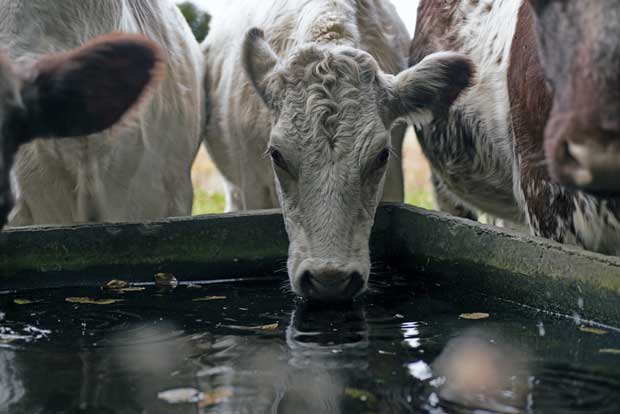

Water is an essential nutrient for humans and animals. Clear and fresh water for humans and animals is getting a challenge more and more, and water quality and quantity concerns are becoming more important across the world. Water is required for the regulation of body temperature, as well as for growth, reproduction, lactation, digestion, metabolism, excretion, hydrolysis of nutrients, transport of nutrients and waste, joint lubrication plus many other functions.
The most important aspect of water as a nutrient is generally the quantity consumed. Depression of water consumption due to contaminants is more common than an imposed mineral imbalance. Some salts and other elements when found in water at higher levels may reduce animal growth and production or may cause illness and death. However due to their physiological adaptability many animals are able to ingest a wide variety of different types of water and survive.
As with feed ingredients, livestock water should meet the nutritional needs of the animal. An adequate and safe water supply is essential for healthy livestock and poultry. Water that adversely affects the growth, reproduction, or productivity of livestock and poultry cannot be considered suitable. Therefore all farm water supplies, either surface or ground, should be protected against contamination from microorganisms, chemicals and other pollutants.
Substances that originate on livestock farms and often contaminate water supplies include nitrates, bacteria, organic materials, and suspended solids. A high level of suspended solids and an objectionable taste, odor or color in water can cause animals to drink less than they should.
Rainwater management
Rainwater management is probably the most neglected and misunderstood aspect of livestock production in solving part of the problem. An intelligent land planning and rainwater management will help farmers enlarge their flocks of livestock to an extent which may now seem to be impossible.
Today, many thousands of hectares in Sub-Saharan Africa consist of impermeable paving, dreary detention basins, compacted soils, turf grass and landscaping that require an inordinate amount of money, energy and non-renewable resources to maintain. Where rainwater harvesting and sustainable ecosystems are the basis for the planning and design of livestock production systems, such systems and the native flora and fauna could flourish side by side.
Arid and semiarid areas are home to one-sixth of the world’s population, most of whom are poor agro-pastoralists who depend totally on renewable natural resources for their livelihoods. The inhabitants of these regions are among the poorest people in the world. Their poverty is partly caused by inadequate supplies of water for crop, livestock and other enterprises. However, the shortage of water is not due to low rainfall, as is commonly perceived, but rather by a lack of capacity for sustainable management and use of available rainwater. The most critical management challenge is how to deal with rainfall variability – short periods when there is too much water and long periods of too little water. Better management of available rainwater could help to reduce the occurrence, and mitigate the impact, of droughts during dry periods or in places with low rainfall. The current approach to food security considers self-sufficiency at the household level and focuses on overcoming water limitations.
Subsistence producers who lack water give priority to minimizing risks at the expense of increasing productivity and profits. This is a strategic survival mechanism but it denies people the opportunities of building the capital resources required to
Invest in new technologies;
Participate in the market economy; and
Protect against extremes of climatic and economic downturns.
The technologies and skills required to overcome the lack of water resources, and poor and extremely variable rainfall, although well known, are not available and widely used. As a consequence, water supplies for agriculture, drinking and sanitation, and the environment are critically low.
Poor access to water is among the leading factors hindering sustainable development in semiarid and arid regions. Approaches to overcoming this problem include technologies for enhancing the productivity of water in rainfed production, rainwater harvesting and precision irrigation. Techniques to improve rainwater management, such as bio-swales that allow rainwater to seep into the ground as it flows away from parking lots, porous pavements, rain gardens and perforated diffuser pipes to capture and slowly dissipate water, are all readily available. However, people need to be made aware of them and educated about them.
Water consumption varies widely, depending upon physiological and environmental conditions, for example the type and size of the animal, if the feed contains much water (for example juicy grass), they need less to drink. If they are active, they need more, and if they are lactating, they clearly need much more. Likewise, weather conditions will influence their need for water: heat, humidity and wind will all influence on the water need.
Water (and shelter) should be available at all times (except for camels, they can do with water every 5-8 days) and be clean and fresh.
Remember that young animals also need water! Even when they are milk fed, it is not always fulfilling their needs for liquids, especially not if active and if it is warm or hot and dry, or maybe even windy.
Summary of water requirements for different animal typres in litres /day.
Camels – every 5-8 days as much as they can drink (up to 100 liter or one third of body weight) daily about 15-30 litres
Beef cattle – 35-60 per head
Dairy cattle – 30-80 per head
Horses – 24-36 per head
Donkeys/mules – Twice a day as much as they can drink (10-25)
Pigs – 15-25 per head
Sheep and goats – 5-20 per head
Chickens – 40-50 per 100 birds = 0.5 litre per bird
Turkeys – 40-75 per 100 birds = 0.75 litre per bird
Rabbit – 50-150 Millilitre (=0.1 litre) water per kilogram bodyweight (small cup)
 Contact Jaguza Support
Contact Jaguza Support